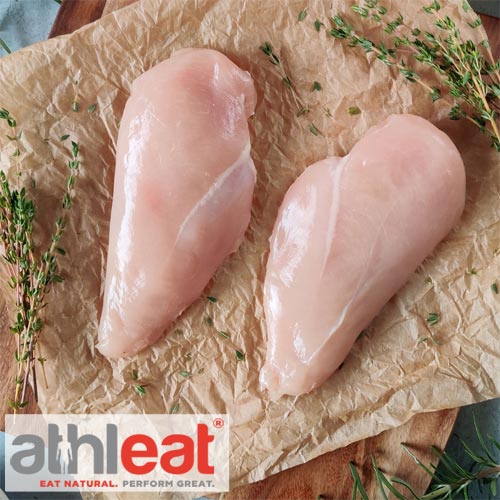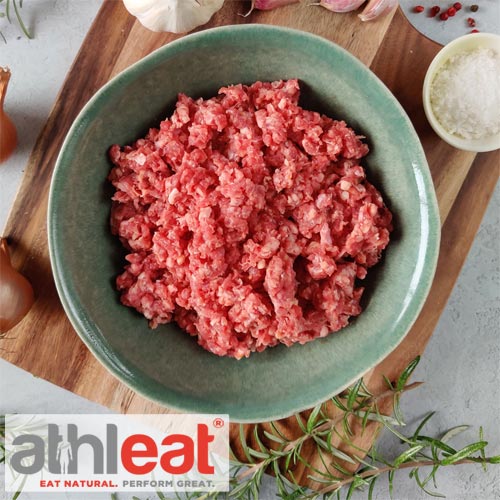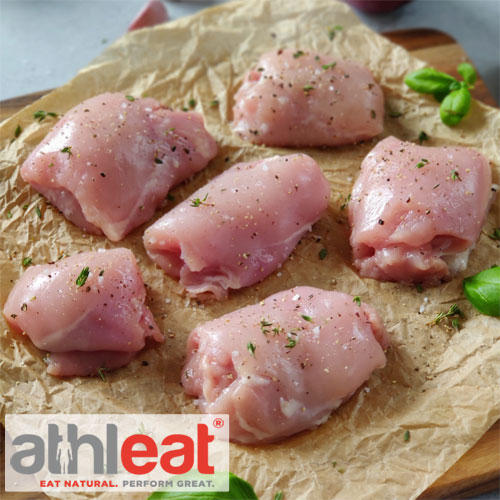Have you ever wondered exactly what it is that makes grass fed beef taste different?
Or perhaps how it compares to grain fed or grass finished beef?
Whatever your question is, we’ll hopefully have it covered, as we’ve answered eight of the most frequently asked questions about grass fed beef.
Check them out below…
Q. Isn’t all beef grass fed?
A. To a certain extent, yes – all cattle that produce beef have been fed grass at some point in their lives, but they may also have been fed other food sources, such as grains.
At Athleat, when we refer to our beef as being grass fed, it’s because our cows have been fed grass throughout their entire lives – from birth to slaughter (also known as grass finished… see below!)
Q. Is all grass fed beef the same?
A. As mentioned in the question above, grass fed can be widely used to describe beef from cattle that have been grass fed at any point in their lives.
As it’s not strictly regulated, cattle that have been grain fed could be labelled grass fed as they technically started their life on a diet of grass and their mother’s milk.
Alternatively, cattle whose diet is only supplemented with grasses could also be labelled as grass fed.
The best way to ensure you’re choosing true grass fed beef is to look for “grass fed” or “grass finished” beef.
Q. What’s the difference between grass fed and grain fed?
 A. By definition, grass fed cattle eat a natural diet made up of grass and other natural food sources, and grain fed cattle eat a more unnatural diet made up of grain, corn and soy.
A. By definition, grass fed cattle eat a natural diet made up of grass and other natural food sources, and grain fed cattle eat a more unnatural diet made up of grain, corn and soy.
Aside from (and as a result of) the way they are reared, another key difference is the flavour of the beef. Grain fed farmers have a lot more control over what their cattle eats, so the flavour between cows does not tend to vary as much.
Grass fed beef also tends to be far kinder for the animal and to the environment, as they live a more natural life.
Q. What’s the difference between grass fed and grass finished?
A. Grass finished beef means the cattle have grazed on grass for their entire lives, right from birth to slaughter.
Other cattle are fed grass for most of their lives but are then moved to feedlots where they are finished with grains before slaughter.
As mentioned above, beef that’s labelled “grass fed” does not necessarily mean the cows have been fed grass their entire lives – this only applies to “grass finished” beef.
Q. How does grass fed beef taste different?
A. Grass fed cattle are allowed to roam about and graze as they please – they aren’t confined to feedlots where they eat and eat. This means that grass fed beef tends to be far more muscular and leaner, which leads to a meatier texture.
The flavour of the beef depends entirely on the fat, which is determined by the cow’s diet. With a more natural diet, the flavours tend to be far richer and “beefier” compared to that of grain fed cattle.
Q. Why is grass fed beef more expensive?
A. The short answer is that it tends to be more expensive because production costs are higher.
Raising grass fed cattle is a longer process, plus the cost of the land required to allow the cattle to roam compared to the smaller spaces required for a feedlot.

Q. Is grass fed beef healthier?
A. Grass fed beef tends to be far leaner and also contains more omega 3 and other key nutrients than its grain fed counterpart.
As the cattle live a more natural lifestyle, the beef is far less likely to contain any harmful bacteria, making it safer too.
Q. What do the cattle eat in winter?
A. The land that grass fed cattle are raised on is usually large enough to provide both fresh pasture during the warmer months, as well as being able to provide enough grass to be harvested and stored ready for the winter months.
This means that the cattle are still able to maintain their grass fed diet, even during the winter months.
So, there you have it! These are some of the most commonly asked questions about grass fed beef (but if you have any of your own questions, you can always drop an email to us on info@athleat.co.uk).
Does that get your taste buds tingling and are you itching to try some for yourself to see what makes it so good?
At Athleat, our beef is grass fed and grass finished – meaning our cattle eat nothing but grass, supplemented by hay in the winter, and are never confined to a feedlot.
So, if you’re ready to give some delicious grass fed beef a try, then click here and place an Athleat order!
Have you ever wondered exactly what it is that makes grass fed beef taste different?
Or perhaps how it compares to grain fed or grass finished beef?
Whatever your question is, we’ll hopefully have it covered, as we’ve answered eight of the most frequently asked questions about grass fed beef.
Check them out below…
Q. Isn’t all beef grass fed?
A. To a certain extent, yes – all cattle that produce beef have been fed grass at some point in their lives, but they may also have been fed other food sources, such as grains.
At Athleat, when we refer to our beef as being grass fed, it’s because our cows have been fed grass throughout their entire lives – from birth to slaughter (also known as grass finished… see below!)
Q. Is all grass fed beef the same?
A. As mentioned in the question above, grass fed can be widely used to describe beef from cattle that have been grass fed at any point in their lives.
As it’s not strictly regulated, cattle that have been grain fed could be labelled grass fed as they technically started their life on a diet of grass and their mother’s milk.
Alternatively, cattle whose diet is only supplemented with grasses could also be labelled as grass fed.
The best way to ensure you’re choosing true grass fed beef is to look for “100% grass fed” or “grass finished” beef.
Q. What’s the difference between grass fed and grain fed?
A. By definition, grass fed cattle eat a natural diet made up of grass and other natural food sources, and grain fed cattle eat a more unnatural diet made up of grain, corn and soy.
Aside from (and as a result of) the way they are reared, another key difference is the flavour of the beef. Grain fed farmers have a lot more control over what their cattle eats, so the flavour between cows does not tend to vary as much.
Grass fed beef also tends to be far kinder for the animal and to the environment, as they live a more natural life.

Q. What’s the difference between grass fed and grass finished?
A. Grass finished beef means the cattle have grazed on grass for their entire lives, right from birth to slaughter.
Other cattle are fed grass for most of their lives but are then moved to feedlots where they are finished with grains before slaughter.
As mentioned above, beef that’s labelled “grass fed” does not necessarily mean the cows have been fed grass their entire lives – this only applies to “grass finished” beef.
Q. How does grass fed beef taste different?
A. Grass fed cattle are allowed to roam about and graze as they please – they aren’t confined to feedlots where they eat and eat. This means that grass fed beef tends to be far more muscular and leaner, which leads to a meatier texture.
The flavour of the beef depends entirely on the fat, which is determined by the cow’s diet. With a more natural diet, the flavours tend to be far richer and “beefier” compared to that of grain fed cattle.
Q. Why is grass fed beef more expensive?
A. The short answer is that it tends to be more expensive because production costs are higher.
Raising grass fed cattle is a longer process, plus the cost of the land required to allow the cattle to roam compared to the smaller spaces required for a feedlot.
Q. Is grass fed beef healthier?
A. Grass fed beef tends to be far leaner and also contains more omega 3 and other key nutrients than its grain fed counterpart.
As the cattle live a more natural lifestyle, the beef is far less likely to contain any harmful bacteria, making it safer too.

Q. What do the cattle eat in winter?
A. The land that grass fed cattle are raised on is usually large enough to provide both fresh pasture during the warmer months, as well as being able to provide enough grass to be harvested and stored ready for the winter months.
This means that the cattle are still able to maintain their grass fed diet, even during the winter months.
So, there you have it! These are some of the most commonly asked questions about grass fed beef (but if you have any of your own questions, you can always drop an email to us on info@athleat.co.uk).
Does that get your taste buds tingling and are you itching to try some for yourself to see what makes it so good?
At Athleat, our beef is 100% grass fed and grass finished – meaning our cattle eat nothing but grass, supplemented by hay in the winter, and are never confined to a feedlot.
So, if you’re ready to give some delicious grass fed beef a try, then click here and place an Athleat order!





